
- Traditional Dances from Uganda - Vol. IV - VI
|
Face Music - Catalog - Uganda |
|
P & C December 1998 - last update 02-2017 |
Harvest Celebration and Social Gathering Songs
This is also a children play dance, and it is performed, when the sky in the Acholi land hosts the full moon. On the occasion of this, the children are not able to sleep early, as they are kept awake by the bright moonlight; they stay in their parents‘ courtyard and play. The run around and blow the wunderful whistle, which also attracts the neighbouring children who come along. Under the bright moonlight, the girls sing and dance, integrating everyday motifs and movements like jumping, bouncing and shaking their hips into their dances. Late at night, however, everybody will become tired and go to bed. 2. Nankasa, Baakisiimba, Muwogola - This is a social gathering dance of the Baganda people. - Aisha Nakato - lead voice, backing voice, ululation 3. Agwara - This is a social gathering dance of the Lugbara people. - Aisha Nakato - lead voice, backing voice Is a dance of the Lugbara and Kebu people in the West Nile region, bordering the Congo and the Sudan. The dance got its name from the agwaras, the local trumpets. The men play these horns as the women dance.
4. Tamena Ibuga - This is a harvest celebration dance of the Basoga people. - Aisha Nakato - lead voice, backing voice 5. Ekizino - This is a harvest celebration dance of the Bakiga people. - Aisha Nakato - lead voice, backing voice, engalo (handclapping) The weather in this region is similar to that of many European mountain countries, and the region is often called the "Switzerland of Africa". During colder seasons, Ekizino is the warm-up dance. Kigezi is a hilly region, the men who go out for farming early in the morning, must jump around for a while to get warm and also stretch their muscles after the hard work. Traditionally, the people also used to stamp the ground until they found signs of water. Therefore, this dance represents their jumping and stamping.
6. Ekitaguriro - This is a harvest celebration dance from the Banyankore people. - Aisha Nakato - lead voice, backing voice This dance comes from the Ankole region. It is an old dance for both men and women. It is occasionally performed to demonstrate the love of the Ankole people for their cattle. This cattle breed has very long horns so making the dance aerial. The singing in this dance is similar to the sounds of the cow. You can even hear the sounds of the milk flowing from the udder of the cow in this dance. The flute that is played during the dance is the same that is used to herd cattle. The stamping movements of the men in this dance are similar to the walking movements of a cow, and the hands of the women just demonstrate the long beautiful horns of the cow.
Courtship and Wedding Songs1. Akogo - This is a courtship dance of the Iteso people. - Aisha Nakato - lead voice, backing voice, ululation Is a courtship dance from the Teso region in northeastern Uganda. This dance shares characteristics with the Larakaraka ceromonial dance from the Acholi, and it is similar to the Runyege courtship dance of the Batooro. The music for this dance, however, is played more softly on melodic instruments such as the thumb piano (akogo) and the flute (endere). 2. Larakaraka - This is a courtship dance of the Acholi people.
Is a ceremonial dance from the Acholi, who have borders with the Sudan. It is primarily a courtship dance that is performed during weddings. When the young people in a particular village are ready for marriage, they organize a big ceremony where all potential partners meet. As a sign of friendship, food and alcoholic drinks are served during this ceremony. Only the best dancers will get partners, so there is a lot of competition during the dancing. In Acholi, if you are a poor dancer, you are likely to die as a bachelor. 3. Mbaga - This is a wedding dance of the Baganda people. - Aisha Nakato - lead voice, backing voice, endege (ankle bells)
4. Runyege - Entogoro - This is a courtship dance of the Banyoro people.
Is similar to the Larakaraka dance of the Acholi people. This is a ceremonial dance of the Bunyoro and Batooro Kingdoms. It is also a courtship dance performed by the youth when it is time for them to choose partners for marriage. The dance was named after the rattles (binyege / ebinyege / entongoro) that are tied on boys' legs to produce sounds and rhythms. The sound produced by rattles is more exciting as it is well syncopated as the main beat is displaced but everything blends with the song and drum rhythms. 5. Ekaro - This is a wedding dance of the Karimojong people. - Aisha Nakato - lead voice, backing voice, engalo (handclapping) This region has a high proportion of migrants from Kenya and the southern Sudan, who are married to Uganda people. They have remained to a great part nomads and pastoralists, frequently being involved in fights over their cattle. They have an aggressive character, which is typical for their nature and origin. The region is very hot and hilly. The Karamoja land has rich gold ressources, and, in spite therof, the region is only little developed. This region constitutes an interesting cultural area having strange dances and songs.
6. Ekoche - This is a courtship dance of the Langi people. - Aisha Nakato - backing voice, ululation
|
| - Aisha Nakato - backing voice - Sylvia Namulema Kigula - lead voice, backing voice - Ronnie Mwabaza - backing voice, engolabi (lead drum), whistle - Israel Kalungi - backing voice, namunjoloba (small drum), endege (ankle bells) |
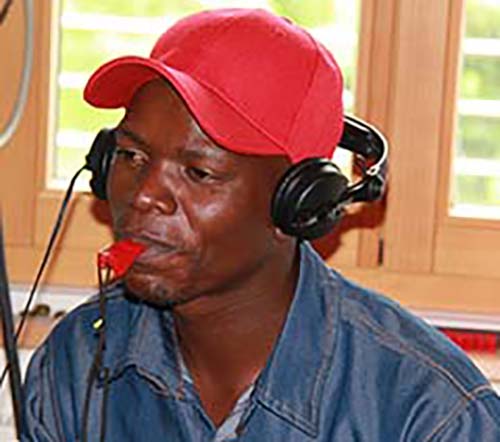 |
| Ronnie Mwabaza - whistle |
As told in this war dance, men as well as women are ready to defend their tribe against an attack. Equipped with weapons like spears, axes and bush knives (pangas) and daggers, they are ready. The women support their men. They signal the attacks and provide their men with new weapons. Men as well as women defend themselves together against attacks in conflicts among the tribes in the north.
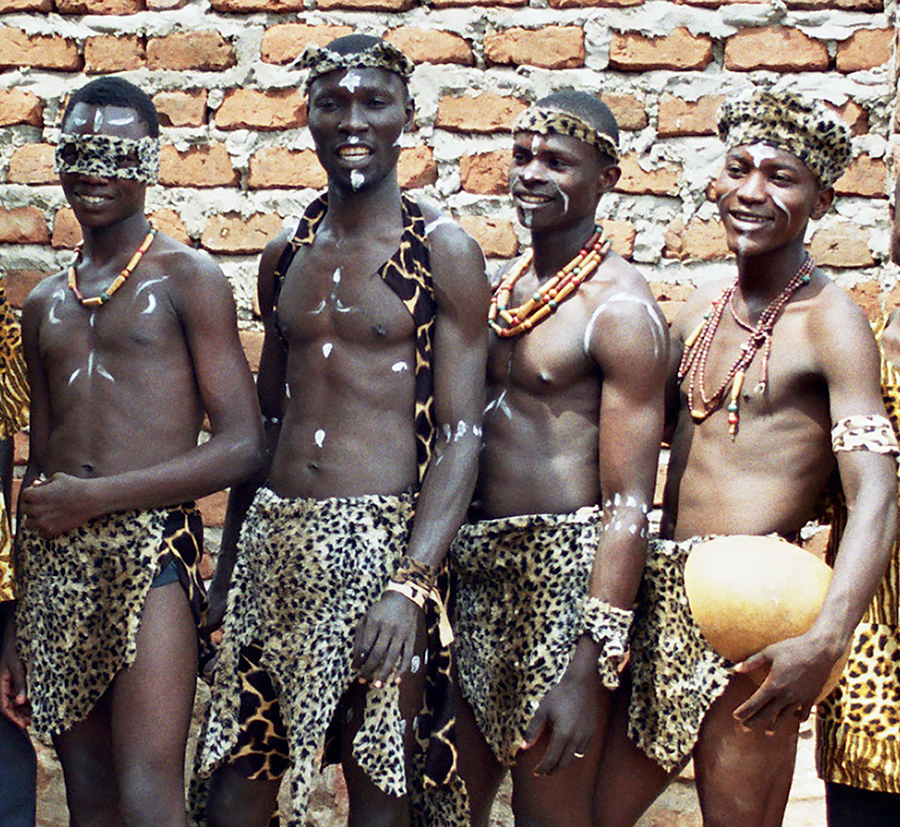 |
Members of the Naggalabi Indigenous Theater in costumes of Langi warriors - from left to right: Richard Kasume, Eric Jjemba Lutaaya, Fred Lutwaama |
4. Mwaga - This is a ritual song of the Bagisu people.
- Aisha Nakato - lead voice, backing voice
- Sylvia Namulema Kigula - backing voice, endege (ankle bells)
- Ronnie Mwabaza - lead voice, backing voice, engalabi (long drum)
- Israel Kalungi - backing voice, adungu (bow harp), akogo (thumb piano), embuutu (big drum), namunjoloba (small drum)
Is a ceremonial initiation dance of the Bagisu people, who live in eastern Uganda on the border to Kenya. They believe that for a young boy to become a man, he must be circumcized in a ceremony that is reflected in the dance.
Before this initiation, the young boy must dance for 21 days, and only then will he possess the spiritual powers with no fear and become a man. If a man, even an elderly one, does not go through this ceremony, he will never be referred to as a man, and he will never earn the respect of the community. He will actually be cursed until the spirits force him to perform this ceremony.
| The Bamasaaba (Bagisu) are famous for their traditional male circumcision ceremonies, held every year. This ceremony is an important cultural link between the local people around Mt. Elgon. Today during the three-day-ceremony of dancing, visiting friends and family, feasting and receiving gifts, preceded by a couple of months of preparations, e.g. bamboo strips being handed down to the candidate by the eldest uncle on the father's side in order to symbolize the responsibility and strength needed to face the challenge of manhood, the candidate is decorated with skins and waves two black and white colobus monkey tails in the air as he is accompanied in his running across villages. A combination of sounds, including the ringing of bells attached to the candidates, fiddles, flutes, and group songs, makes this event memorable to anyone watching. Intricate rhythms are played on different traditional drums of differing pitching, and this creates and often stimulates the dancing of everyone present. The person undergoing circumcision is accompanied in the running across the villages, and at the end of it he must be strong and he is not expected to make noise (scream) during circumcision, as otherwise the family will be very embarrassed. It is of great importance for the candidate to "quietly" stand strong during the circumcision to show that he is capable and ready to become a man. The initiates are admitted into adulthood after this ceremony and are expected to begin their formal contribution to the growth of their respective communities. Unlike the Bagisu, the Sebei also circumcise women. | 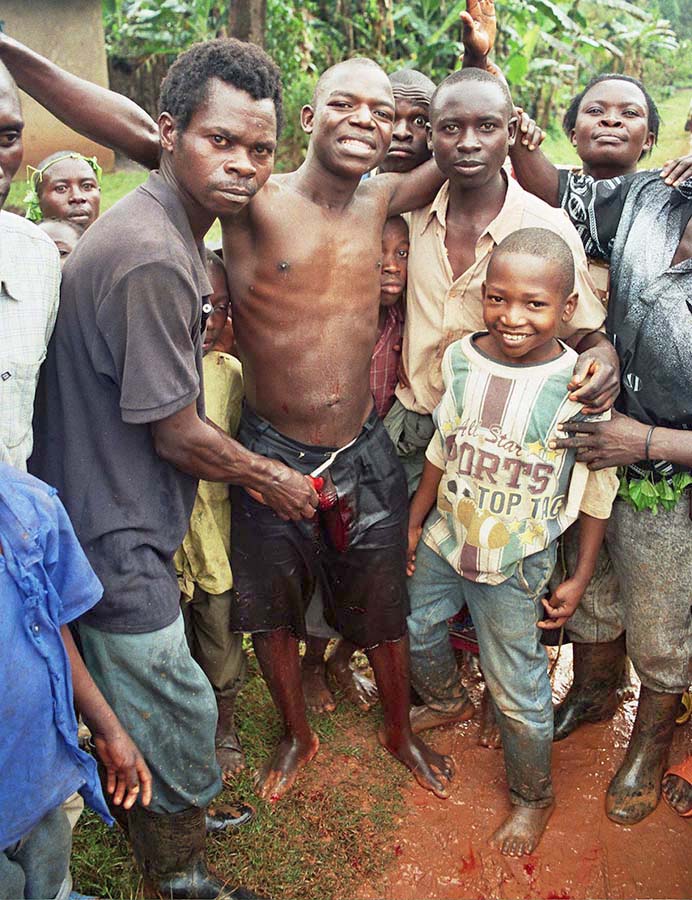 |
| Bagisu people - male circumcized ceremony |
5. Empango - This is a worship dance of the Batooro people.
- Aisha Nakato - backing voice, akacence (shakers)
- Sylvia Namulema Kigula - backing voice, embuutu (big drum)
- Ronnie Mwabaza - lead voice, backing voice, adungu (bow harp)
- Israel Kalungi - lead voice, backing voice, adungu (bow harp), embuutu (big drum), namunjoloba (small drum)
This dance is like a procession and worshipping ceremony for the king. The king who is like a god is shown deepest respect. In this way, respect is also shown to the royal family as well as the entire court.
Such a ceremonial dance is also performed in other royal palaces by the king’s subjects in great grace.
6. Ekimandwa - This is a worship dance of the Bakiga people, which is still being dance by the Banyankore people.
- Aisha Nakato - lead voice, backing voice
- Sylvia Namulema Kigula - lead voice, backing voice
- Ronnie Mwabaza - lead voice, backing voice, namunjoloba (small drum), ensaasi (shakers)
- Israel Kalungi - backing voice, embuutu (big drum)
This is a religous dance of the Bahiru people, a worship dance for the god Okubandwa. Kimandwa is derived from the word „emmandwa“ and means the spirits that people get possessed with during the dance performed in this ritual. They believe that sanity (sacrifices) and happiness (joy and love) which they present with this dance place god in a good relationship with the community.
Baganda people
The Baganda people make up the largest ethnic group in Uganda. (The name Uganda, the Swahili term for Buganda, was adopted by British officials in 1884 when they etablished the Uganda Protectorate, centered in Buganda).
They speak a Bantu dialect called Luganda belonging to the Niger-Congo family. Like many other African languages, it is a tonal language which means that some words are differentiated by means of pitches. Words that are spelled in the same way, however, have a different meaning. It is a language that is rich in metaphors and proverbs. Buganda is located in central Uganda and it is a region of the Baganda people. Its centre is Kampala city. Buganda's boundaries are marked by Lake Victoria in the south, the Victoria Nile River on the east, and Lake Kyoga on the north. The kingdom comprises 52 clans. At present it is the largest of the traditional kingdoms.
Their music is mainly slow with more emphasis on a regular meter. It is composed of contrasted lyrics and yodles (flactuating vocal lines). Since they are of Negroid origin, they have a huge variety of song forms such as; lullabies, historical songs, work songs, ceremonic songs, praise the kings (royal songs), wedding songs, etc. Their scale is purely pentatonic. Most of the vocally lines are in a responsarial form, solo form and chorus form. Since these songs are vocal dominant, they are basically meant to deal with social transformation. Funerals are major ceremonial and social events.
Basoga people
The Basoga - before the arrival of the Europeans, they had been subsistence farmers who also kept cattle, sheep, and goats. They commonly maintained gardens for domestic use close to the homestead. Busoga is located right at the source of River Nile in the East, and this is where the Basoga tribe lives. Its nucleus is Jinja town.
Early inhabitants of this region were Nilo-Hamitic tribes like the Langi und Iteso as well as the Bagisu (a Bantu tribe). Subsequently, the Basoga who had immigrated from the East expelled them and also adopted their traditions and lifestyle. The clan chiefs defined daily life in the society, and they distributed land for cultivation.
Bagisu people
The Bagisu is located in the eastern region of Uganda near Mt. Elgon to the border to Kenya. It is the place of the Bagisu tribe whose origin lies with the Negros. Its nucleus is Mbale town. They occupy the well-watered western slopes of Mount Elgon, where they grow millet, bananas, and corn for subsistence, and coffee and cotton as cash crops. This area has the highest population density in the nation, as dense as 250 per sq km. As a result, nearly all land is cultivated and land pressure has led to the migration of the population and to social conflicts.
Ancestral worship and magic are common. The people either tried to ban evil by means of magic, or they contacted a medicine man prescribing herbs for the cure of illness and disease. Men as well as women having spiritual power were consulted or asked to avert a prevailing threat by means of ritual acts. Ceremonies with sacrifical offering were performed in order to appease the spirits or simply to thank them for a good harvest. Oracles were often consulted. The administration of justice was based on magical signs. Wedding rites (it was allowed to marry several women) and the circumcision of men are still alive today. Agriculture like the cultivation of land in combination with the breeding of livestock was also common. Unique is only the breeding of donkeys for the transport of goods, which in Africa are usually carried by women on their heads.
Their vocal lines are rhythmically complex with many variations, and they are characterised by the hexatonic scale. The music is mainly fast with characteristics being similar to that of the Buganda.
Batooro - Banyoro people
The people of Bunyoro are known as Banyoro (singular Munyoro). They belong to the Kingdom of Bunyoro-Kitara in western Uganda, in the area to the immediate east of Lake Albert. Their cultural leader is the omukama (king). Bunyoro-Kitara Kingdom is the districts of Hima, Masindi and Kibale. The native language is Runyoro-Rutooro, a Bantu language. Runyoro-Rutooro is also spoken by the people of Toro (Batooro) Kingdom, whose cultural traditions are similar to those of the Banyoro.
They were polygamous, and the dowry was often paid after several years of marriage. Death was usually attributed to sorcerers, ghosts and other non-human agents. Death was the result of action on the side of bad neighbours, provided with a vast range of magical and semi-magical means of injuring and even killing others. Indeed, many deaths were attributed to the act of sorcery by ill-wishers. They celebrated the new moon and an annual ceremony called "empango". The basis of the kingdom was the family head "Nyineka". Each village had an elder chief known as "Mukuru w'Omugongo".
Guests were always welcome and always regaled with something, even if they arrived after midnight. Their craftsmen were also very talented, and there was a flourishing trade in durables with the regions outside the kingdom. The blacksmiths working metal were also well-respected, especially for their production of hoes for the cultivation of the fields.
The melodies are based on a constant meter with two distinctive rhythms (runyege and entongoro). Their vocal lines are characterised by massive yodelling (melismatic lines). Their music is mainly responsorial in nature. They are the origin of Bushmen and Negro people, and their music is clearly pentatonic.
At times, their vocal lines are polyphonous.
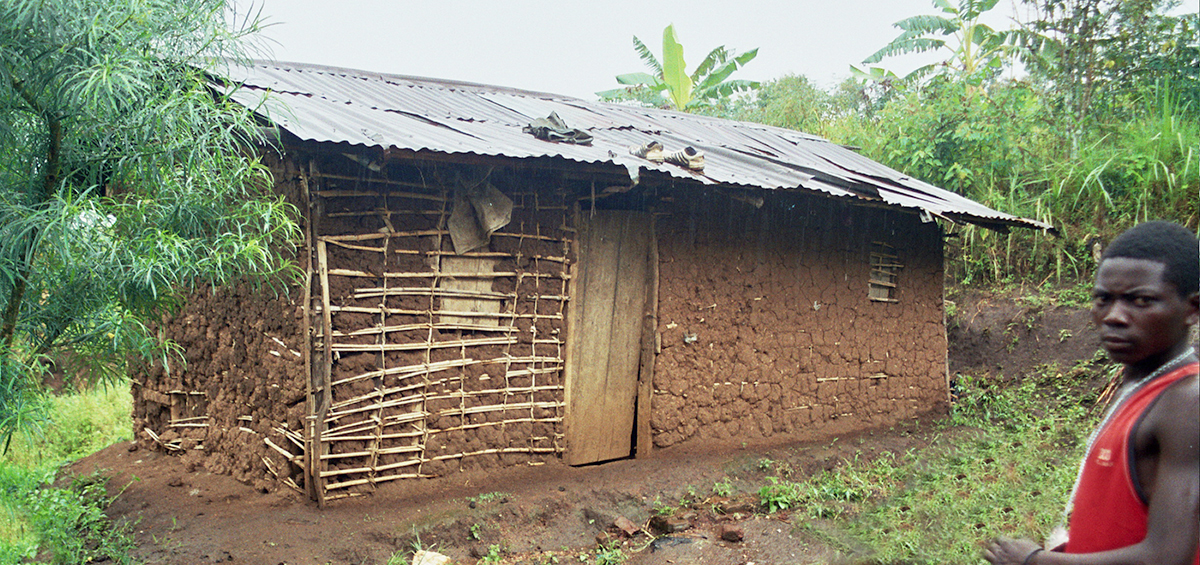 |
| Bantu houses are made of a double layer of plaited bamboo filled with clay |
Banyankore people
Their vocal music is characterised by old type poetry recitals which in many cases signfy bravery, elongated vocal lines in imitation of the mowing cattle. Their vocal melodies are mainly responsorial in nature and at times polyphonous.
The Ankole region, also referred to as Nkole (Nyankore), is one of the four kingdoms in Uganda. It is located in the southwest of Uganda to the west of Lake Edward. The Ankole people was usually known as Kaaro-Karungi, and the expression Nkore is said to have been adopted during the 17th century following the devastating invasion of Kaaro-Karungi by Chawaali, the then Omukama (king) of Bunyoro-Kitara. The word Ankole was introduced by the British colonial administration to describe the greater kingdom which was formed by adding to the Nkore realm the former independent kingdoms of Igara, Sheema, Buhweju, and parts of Mpororo.
It is ruled by a monarch (mugabe = king). The Banyankore people also belong to the Bantu groupe and are great cattle keepers. They breed long white-horned cows that give beef, milk and other products and are most prestigious for the farmers. The breeders are so proud of their cattles, so that they own them in large numbers and these animals exert great influence on their daily life routine, especially in rituals, music and dances. Many songs are about cows. Poetry comprises songs that tell of men who own large herds, tell about their individual abilities and their special tradition in authorities within the society; brave, wealthy, great warriors and owners of beautiful women.
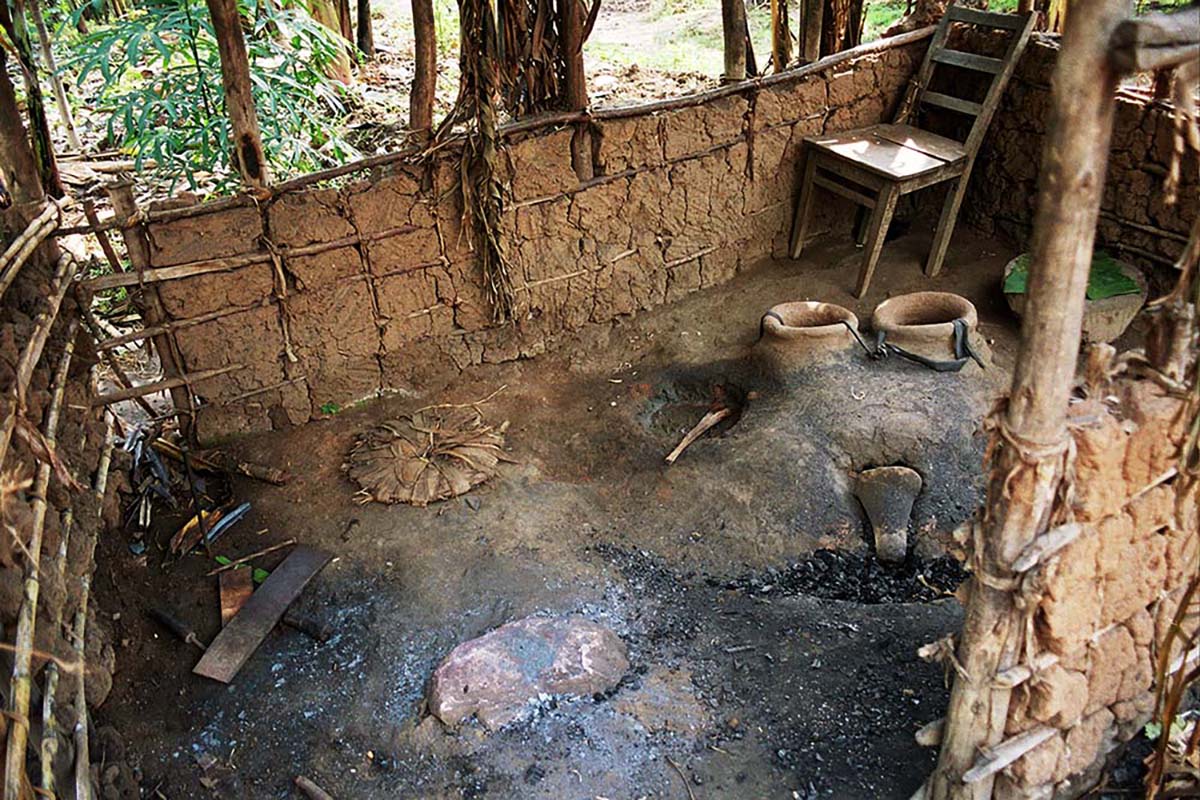 |
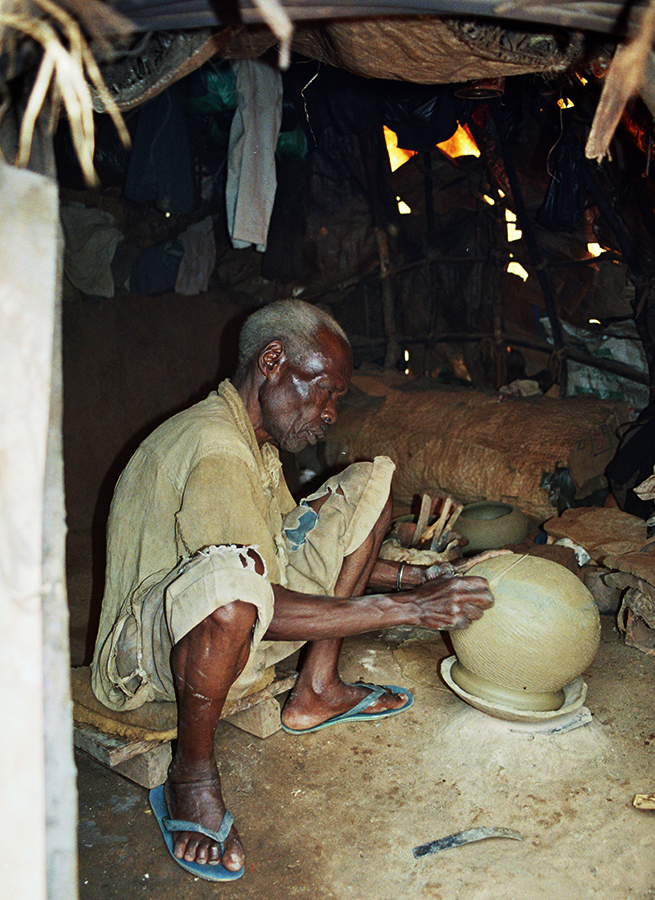 |
| Blacksmoth - workshop | Pottery |
Bakiga people
Kigezi is located in the far south western part of Uganda, and it is the home of the Bakiga tribe. Its nucleus is Kabale and Kisoro town. The early Bakiga are also descendants of the Hamites. Kigezi is referred to as the coldest part of Uganda.
Today's Bakiga are Bantu who immigrated in modern time and have mixed since then with the tribes already living there. They have a system of clans which is hierarchically structured. It is certain that they have also adopted some Hamitic structures. When a girl got married, the parents had to pay a dowry, and the groom's father or uncle decided. Marriage within the same clan was not allowed, but it was, however, possible to marry several women. Divorce was also legal.
Their highest god was the creator of heaven and earth: he was called Ruhanga (such as with the Banyankore). In addition, there was the Nyabingi cult who was much more common. The people erected special shrines (endero) and made sacrifices in the form of food (roasted meat) and beer. They also practised worship and manufactured cult objects (fetish figures). In addition to the person of the medicine man there was also the rainmaker. A healer or his medium cured illnesses and diseases. The ancestors were asked for advice. Convicted persons were forced to commit suicide: they either hanged themselves in the woods, or they had to jump from high rocks. Murderers were buried alive in their victim's graves.
The Bakiga were rather farmers than livestock breeders, and they were also excellent craftsmen, skilled, for example, in the art of pottery. They also produced household articles such as carpets, rugs, chairs, millstones, etc. The work was always accomplished as a community. Apart from handicraft works, the people also had to fulfill their chores in connection with cultivating land and erecting huts. The men were excellent hunters and also warriors. The blacksmiths melted iron and rather early manufactured knives, spears and also work tools which they were generally renown for.
They also excelled in brewing beer from corn (omuramba), which was, however, only brewed for festivities and rites. On such occasions drums, horns and also the zither (harp – ennanga) were being played. They were wonderful zither players, either performing as soloists or in ensembles.
The Bakiga music was energetic, as the people tried to warm up their body because of the cold weather. Their melodies are characterised by solo singing, chorus and at times responses. The vocal lines of the men and women are in polyphonic style, and they tend to create a counter-point effect.
African zithers have a boat-shaped sound box with a fairly long wooden neck, which enters the resonator. Ancient painting depict these instruments, often in the hands of women.
Iteso people
They speak a Nilotic dialect and belong, together with the Karimojong tribe, to the Atkerin group (Hamites). Today they live in the Pallisa and Tororo district in the eastern part of Uganda, some of them in the Soroti and Kumi district. They believe that their ancestors came in the first half of the 18th century BC from Ethiopia (Abessinia) and had passed through Karamoja land in the east. Historians modified that they belong to the Nilo-Hamitic group (Lwo) and have the same origin as their neighbouring tribes, the Langi, the Karimojong, the Jie and the Kumam, who also came from the north and are now settling in this area.
The clan forms the basis of the social and political unit (commune). It controls administrative and judicial matters. Originally, there were nine clans, with each clan having a leader called Aplon ka Ateker. These were usually elected by other elders at a merry ceremony know as airukorin. The leaders had to present magnificent leader characteristics in order to being able to assume the function of a leader of the people. The leader acted as an arbitrator in the event of disputes and was greatly respected. These titles, however, were not hereditary. The leader of the clan was assissted by a council of elders known as Airabis or Aurianet. They sat court for cases like murder and debts. After setting a dispute, a ceremony known as epucit or aijuk was performed, whereby a bull was offered and killed, roasted and eaten. This was intended to act as a gesture of renewed co-operation between the two parties. The appropriate compensation in form of a cow or a girl would then be handed over.
The social system was centred around the clan, and they shared similar cultural elements with neighboring tribes like the Langi and the Karimojong. They were also influenced by their neighbors, the Bantu, particularly the Basoga people.
Acholi people
The Luo are part of the people from the southern Sudan. The migration brought changes during the 15th century with the Acholi people and with intermarriage. They lost the system of pastoralism and began to speak Luo. Their origin were not the Luo but rather the Nilo-Hamites.
The Acholi had a central government with a representative who was called Rwot (leader). He ruled and held court over life and death for his subjects. He was also the mediator between ancestors and the people.
Acholi folk music is, like most Ugandan music, pentatonic. It is distinctive with choral singing, in parts with a lead voice. Songs are also accompanied by a string instrument, the harp-like adungu and numerous percussion instruments.
The vocal lines of the songs of men and women are in polyphonic style, and they tend to create a counter-point effect. Songs are performed at various occasions. The singing is melodic, and dances are performed collectively. Solo dancing is rather rare. The Acholi have various kinds of dances: Various dances are performed on certain occasions like, for example, birth, funeral, wedding, rituals (ancestral worship), beginning of a hunt, victory over enemies) and the celebration of the seasons (for example, thanksgiving).
Lugbara people
The Madi-Moro group comes from the Sudan and speaks an Eastern Central Sudanic language. They have settled in the north over a period of several centuries. This group includes the Lugbara, Metu, Madi, Okebu and a few small groups; now they live in the northwestern corner of today's Uganda.
The Lugbara live in the highlands on an almost treeless plateau that forms the watershed between the Congo River and the River Nile. The Madi live in the lowlands to the east. The two groups both speak nearly identical languages and have strong cultural traditions. Both groups grow millet, cassava, sorghum, legumes, and a variety of root crops. Chicken, goats, and, at higher elevations, cattle are also important. Beer is brewed from corn, and the people also grow tobacco. They were organised in clans, and their supremeleader was called Opi. He had to be a descendant of immigrants. He also often was the rainmaker. Land and livestock were appropriated to him. He decided on rituals and he decided when it was time to harvest. Jurisdiction was only valid when several clan leaders agreed upon the decision. It was further possible to pay off one's guilt. The father was only the head of his own family, and everybody had to obey his decisions.
Alur people
The Acholi, Langi, Alur and some other smaller ethnic groups belong to the group of the Western Nilotic language, all together making up about 15% of the overall population. Most of the West Nilotic languages in Uganda are called Lower Nilotic, and they are closely related to the language of the Luo in Kenya. The two biggest ethnic groups, the Acholi and the Langi, speak nearly identical languages. Acholi is situated in the northern region of Uganda, this constituting also the home of the Acholi tribe. Its centre is Kitgum town. The tribe is a mixture of Negroids and Hamites. The Alur, who live in the western areas to the Acholi and the Langi, have a similar culture as the neighbouring societies of the West Nile area, where the majority of the people speak a Central Sudanesic language. The area West Nile is situated in the northwestern part of the country, where the tribes of the Kebu, Ondrosi, Lugbara, Kakwa and Alur have found a home, with their origin going back to the Hamites. The centre is the town Arua.
- The Luo are the River-Lake Nilotes: Acholi, Alur, Jonan and Jopadhola.
Langi people
The Langi lost their Ateker language and migrated closer to the Lake Kyogo in the 18th century after living more than two hundred years in the Acholi region. They lost the system of pastoralism and began to speak Luo. Their origin were not the Luo but rather the Nilo-Hamites.
Karimojong people
The Karimojong tribe speaks a Nilotic language and belongs, together with the Iteso and some other small tribes around them (Jopadhola, Sebei, Kumam), to the Atkerin group (Hamites). They settle in the northeastern part of Uganda in the Kotido and Moroto districts. Here it rains only scarcely, and this is why there is performed mainly pastoralist economy. They conserve a distinct group with some elements of their cultural heritage. The mode of living is based on traditional stock without intercultural adaptations. Most people supplement their pastoral economy with crop cultivation, which is mostly in the hands of the women.
- more information about regions you will find under projects: Uganda the country and the people.
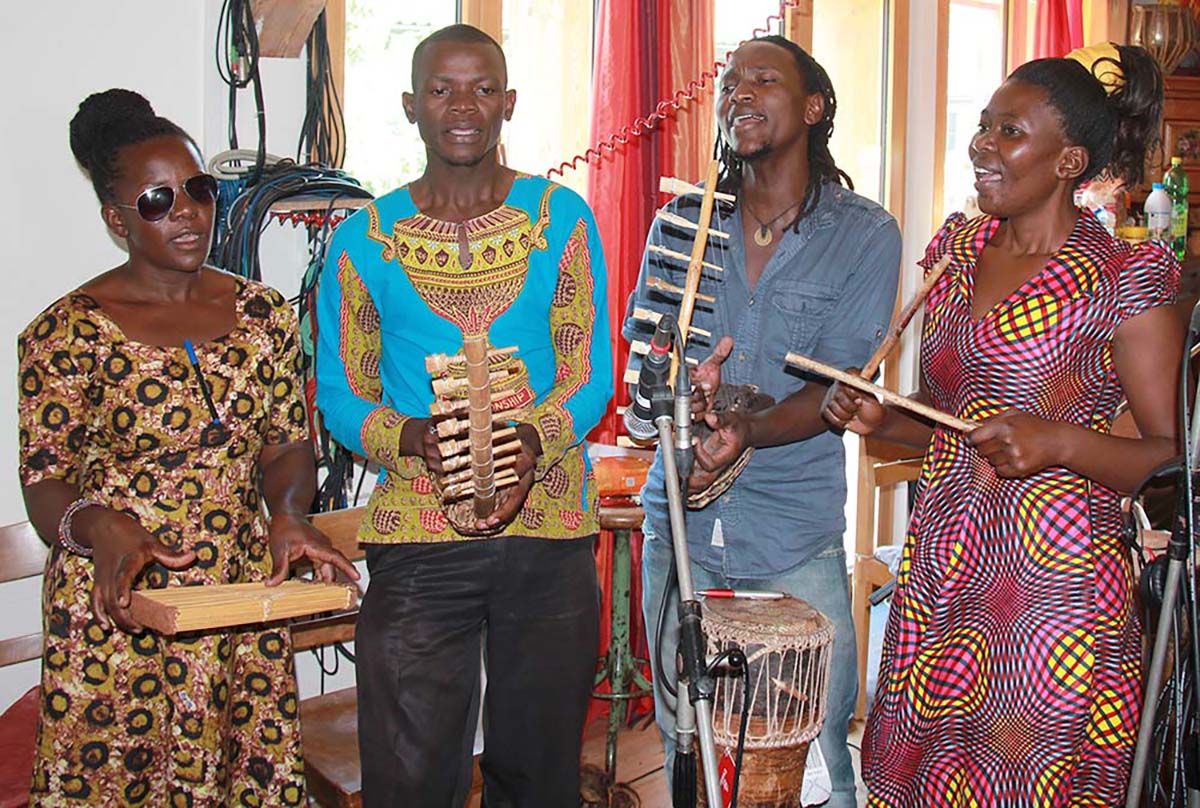 |
| Aisha Nakato - Ronnie Mwabaza - Israel Kalungi - Sylvia Namulema Kigula |
Instruments
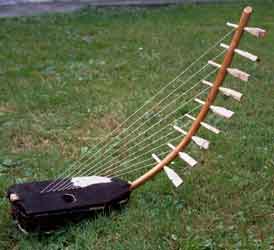 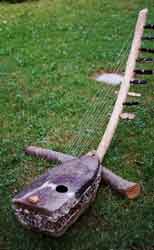
|
- Adungu - bow harp - arched harp - string instument The adungu is a nine-string arched (bow) harp of the Alur people of northwestern Uganda. It is very similar to the tumi harp of the neighbouring Kebu people, and it is also used by the Lugbara and Ondrosi tribes in this northwestern region around the Nile. The harp is used to accompany epic and lyrical songs, and it is also used as a solo instrument or within ensembles. Players of arched harps have had a high social status and are included in royal retinues. Nowadays they also play in churches. The adungu consists of an arched neck, a wooden resonator (sound box) in which the neck is fixed, and a series of parallel strings of unequal lengths that are plucked. The strings are fixed at one end to the resonator and run at an oblique angle to the neck, where they are attached and tuned with pegs. The first, second, and third strings are tuned in octaves with the sixth, seventh, and eighth respectively. In traditional music the instrument is tuned in a pentatonic (five-note) scale, but it can also be tuned in modern style to a diatonic scale. |
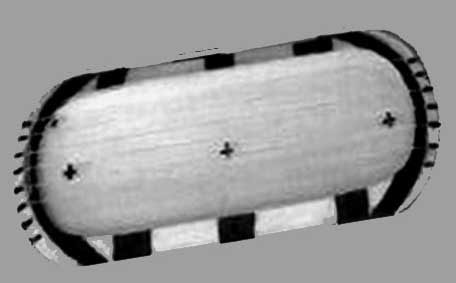 |
- Ennanga - Nanga - wooden zither - string instrument This instrument was brought to Uganda by the Hamites and is common among the Bakiga and Acholi tribes. This string instruments emphasize the narrative and story-telling tradition of the people. Love songs, praise songs, epics, dirge songs and humorous songs. African zithers have a boat-shaped sound box with a fairly long wooden neck, which enters the resonator. Ancient painting depict these instruments, often in the hands of women. The ennanga is strictly a solo instrument and has eight strings, which run above a wooden trough. A zither is an instrument in which the strings run parallel to the resonator, which extends the entire length of the strings. |
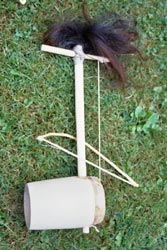 |
- Endingidi - tube fiddle - one-string-fiddle - string instrument |
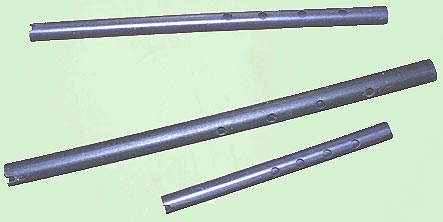 |
- Endere - flute - wind instrument The flute is widely popular in all regions of Uganda with five fingerholes. It is played both as a solo and accompaniment instrument. The instrument is blown at the slightly V-shaped slit end of the instrument, usually with four finger holes. The instruments are not played to accompany dancing, the people use them to play smooth melodies for the grazing cattle or to interpret love songs. In Buganda it can be played solo, in a duet or in small ensembles. |
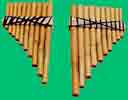 |
- Enkwanzi - panpipe - wind instrument The enkwanzi or oburere is a panpipe that comes from the Busoga region and is made from elephant grass or bamboo. They are stopped flutes, meaning that the node of the plant stops the hollow tube and thus determines the pitch of the pipe. The tubes are arranged from lowest to highest and laced together with string. The open rim at the top of each tube is cut at a right angle to the tube so that the player may blow |
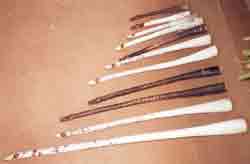 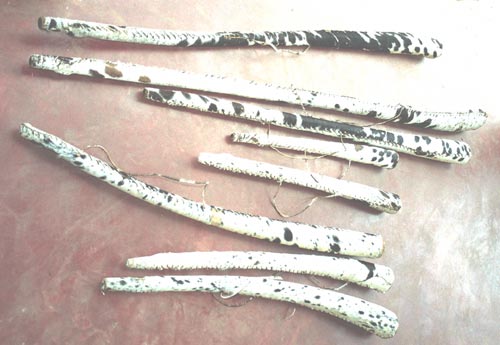 |
.Agwara - side blown horn - wind instrument These come from the Lugbara and Kebu tribes of the western Nile region and are played in groups of seven or more. These side-blown horns sometimes have a single fingerhole, which is used for grace-note ornaments. The instruments of the Iteso and Karimojong people are made of cow horns and have only one mouthpiece; they are only used for communicating or giving signals. |
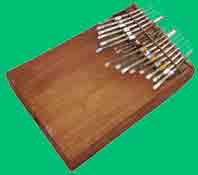 |
- Akogo - Akadongo – thumb piano Many different names exist for this instrument; kalimba, sansa, and mbira are the most common ones. It consists of a series of flexible metal or cane tongues of varying lengths fixed to a wooden plate or trapezoidal sound box. Nowadays the resonator is made of kiaat wood, and the tines are made of high-quality spring steel. The musician holds the instrument in both hands and uses his thumbs to pluck the slightly upturned free end of the tines. The number and arrangement of the tines, or lameliae, vary regionally. The instrument accompanies a repertoire of "songs for thought," or laments, sung by both men and women. In Buganda the instrument is known as "akadongo kabaluru" or "little instrument of the Alur tribe" from the northwest Nile region. |
Drums in African tradition bring the power that drives a performance. Music is not merely entertainment, but it is ultimately bound to visual and dramatic arts as well as the larger fabric of life. Drums may be used for "talking"; that is, sending information and signals by imitating speech. Many African languages are both tonal (that is, meaning can depend on pitch inflections) and rhythmic (that is, accents may be durational), giving speech a musical quality that may be imitated by drums and other instruments. Drumming music and dance are almost always an accompaniment for any manner of ceremony; birth, marriages, funerals.
Engoma (Uganda drumset - percussion instrument) - While larger versions of this drum are traditionally hand-carved from old-growth hardwood trees, now these drums are made with pinewood slats tied together like barrels. Smaller drums are laminated and turned on a lathe and may be provided with a rope carrying the handle. All these drums have heads made from hide held by hardwood pegs hammered into the side of the drum.
- see more about Traditional instruments of the Uganda people and - Traditional dance of the Uganda people
Revised by Hermelinde Steiner 2017